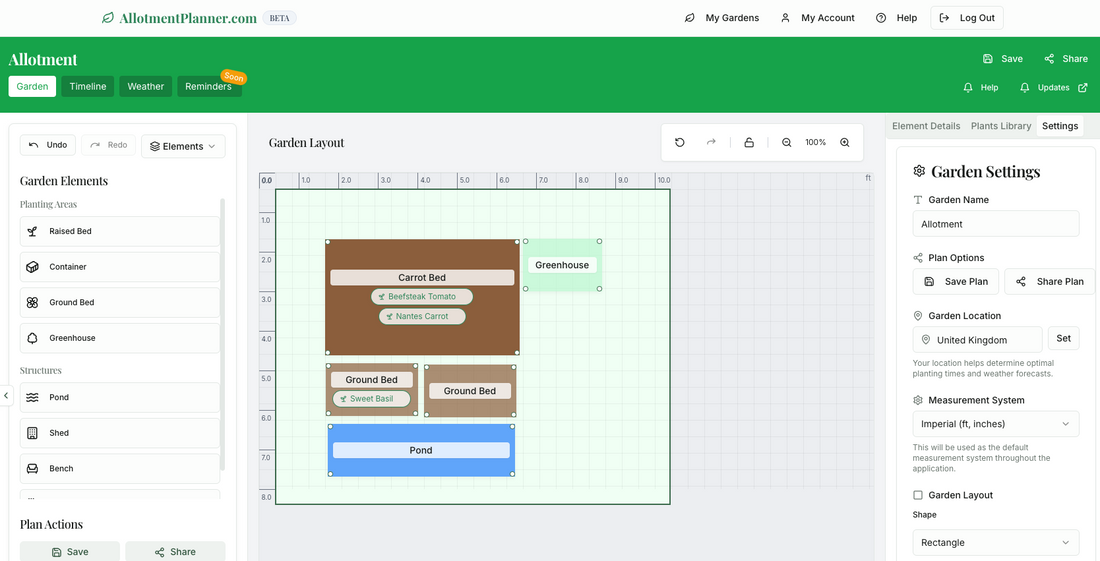
How to plan your allotment garden
An allotment garden is a fantastic way to grow your own fresh vegetables, herbs, and flowers while enjoying the outdoors. However, without proper planning, you might end up wasting space, overcrowding plants, or missing the best sowing times.
In this guide, we'll cover how to plan your allotment garden efficiently, using different methods to suit different styles—whether you prefer a spreadsheet, pen and paper, or online planning tools. By the end, you'll have a clear roadmap for a thriving, organised allotment!
Why Planning Your Allotment is Essential
Before jumping into methods, let’s look at why allotment planning is critical:
✅ Maximises space – Ensures you use every part of your plot wisely.
✅ Prevents overcrowding – Stops plants from competing for sunlight and nutrients.
✅ Improves crop rotation – Helps avoid nutrient depletion and soil-borne diseases.
✅ Optimises sowing times – Ensures you sow and harvest at the right time for continuous yields.
✅ Reduces waste – Stops you from over-planting or under-utilising your space.
Now, let's explore the different ways you can plan your allotment garden and choose what works best for you.
Method 1: Planning Your Allotment with a Spreadsheet 📊
Best for: Detail-oriented growers who like structure and tracking.
Why Use a Spreadsheet?
A spreadsheet (such as Google Sheets, Excel, or OpenOffice Calc) lets you:
✅ Create a planting calendar with sowing, transplanting, and harvesting dates.
✅ Track spacing requirements for each crop.
✅ Manage crop rotation year after year.
✅ Keep notes on soil conditions, pests, and fertiliser use.
How to Set Up Your Spreadsheet
Step 1: Create a Crop List
In the first column, list all the crops you want to grow.
Step 2: Add Key Growing Information
Columns might include:
| Crop | Sowing Date | Planting Out Date | Harvest Time | Spacing | Companion Plants | Rotation Group |
|---|---|---|---|---|---|---|
| Carrots | March | April | July | 10cm apart | Onions, Leeks | Root Crops |
| Tomatoes | Feb (indoors) | May | Aug-Oct | 45cm apart | Basil, Marigold | Fruit Crops |
Step 3: Create a Monthly Overview
Use colour coding for each stage:
🟩 Sowing | 🟦 Transplanting | 🟥 Harvesting
This makes it easy to see at a glance what needs doing each month.
Pros of Spreadsheet Planning
✔️ Easy to update each year.
✔️ Great for succession planting (continuous harvests).
✔️ Tracks crop rotation over multiple seasons.
Cons
❌ Can feel overly technical for some.
❌ Doesn’t provide a visual layout of your allotment.
💡 Tip: If you like spreadsheets but want more visual planning, combine this with pen and paper or an online tool.
Method 2: Pen & Paper Planning 📝
Best for: Traditional growers who prefer a hands-on, creative approach.
Why Use Pen & Paper?
A sketch of your allotment is one of the simplest ways to plan your garden:
✅ Allows you to visualise plant placement easily.
✅ Helps with companion planting by showing where crops will sit next to each other.
✅ Requires no technology, just a ruler and some paper.
How to Plan Your Allotment on Paper
Step 1: Sketch Your Plot
- Use graph paper or a blank notebook.
- Draw your allotment’s shape and dimensions.
- Mark fixed features like sheds, paths, or greenhouses.
Step 2: Add Crops to the Layout
- Draw plant beds and label them.
- Use arrows to indicate tall plants that may cast shade.
- Consider plant spacing and companion planting.
Step 3: Create a Seasonal Plan
- Use different pages for spring, summer, and autumn planting.
- Rotate crops yearly to maintain soil health.
Pros of Pen & Paper Planning
✔️ A tangible, creative way to design your garden.
✔️ Great for seeing spacing and layout at a glance.
✔️ No tech skills required—just a pencil and ruler.
Cons
❌ Hard to update year after year—requires redrawing.
❌ Can become messy if changes are needed.
💡 Tip: Laminate your plan so you can edit it with a whiteboard marker each season.
Method 3: Using Online Planning Tools & Apps 💻
Best for: Gardeners who want a digital, interactive approach.
Why Use an Online Planner?
Online tools can:
✅ Generate a visual allotment layout automatically.
✅ Suggest companion plants for each crop.
✅ Auto-calculate spacing to prevent overcrowding.
✅ Provide a crop rotation guide to help manage soil health.
Best Free & Paid Online Tools
| Tool | Features | Free/Paid |
|---|---|---|
| Allotment Planner | Drag & drop layout, planting suggestions based on weather, harvest dates, visual editor | Free |
| VegPlotter | Custom layouts, plant recommendations, printable plans | Free/Paid |
| Trello (DIY Planner) | Can be used as a custom garden tracker | Free |
How to Use an Online Garden Planner
1️⃣ Create a new plot – Enter the size of your allotment.
2️⃣ Drag & drop plants into the virtual layout.
3️⃣ Use companion planting suggestions for better results.
4️⃣ Save and print your final plan for reference.
Pros of Online Planning Tools
✔️ Easy to update & reuse yearly.
✔️ Prevents spacing mistakes automatically.
✔️ Mobile-friendly—access from anywhere.
Cons
❌ Some advanced features may be behind a paywall.
❌ Requires internet & tech skills.
💡 Tip: Combine an online planner with a spreadsheet for the best of both worlds!
Which Allotment Planning Method is Best?
Each method has its strengths, so choose based on your preferences:
| Method | Best for… |
|---|---|
| Spreadsheet | Detail tracking & crop rotation |
| Pen & Paper | Traditional, hands-on planning |
| Online Tools | Interactive, digital layouts |
💡 Tip: Try combining methods! Use a paper sketch for layout, a spreadsheet for tracking, and an online tool for spacing & crop rotation suggestions.
Final Tips for a Successful Allotment Garden
✅ Start with a simple plan—don’t overcomplicate.
✅ Consider paths & access—leave room to walk between rows.
✅ Label everything!—mark crops clearly to avoid confusion.
✅ Be flexible—adjust based on weather, pests, and growth patterns.
By planning ahead, you’ll have a productive, organised allotment that produces delicious vegetables and herbs all year round.
🌱 Ready to start planting? Browse our range of seeds!
